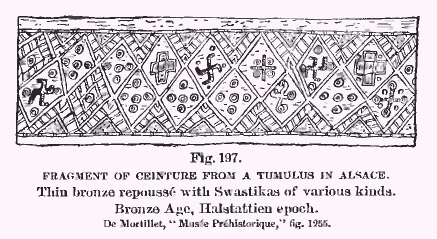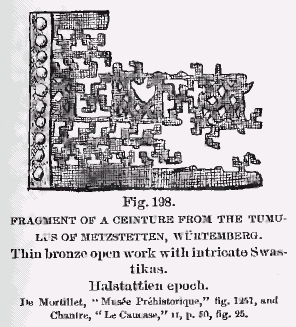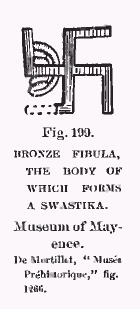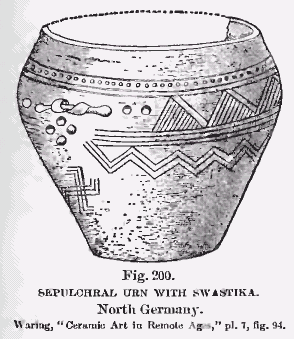

The Swastika
Dispersion of the Swastika

Germany and Austria. Fig. 197 represents a fragment of a ceinture of thin bronze of the Halstattien epoch of the Bronze Age form a tumulus in Alsace. It is made after the style common to that period the work is repoussé and the design is laid off by diagonal lines which divide the field into lozenges, wherein the Swastika is represented in various forms, some turned square to the right, others to the left, while one is in spiral and is turned to the left. Other forms of the cross also appear with dots in or about the corners, which Burnouf associates with the myth of Agni and fire making, and which Zmigrodzki calls the Croix swasticale. This specimen is in the collection Nessel at Haguenau. Another ceinture was found at the same place and is displayed with it. It bears representations of the cross of different forms, one of which might be a Swastika with dotted cross lines, with the arms turned spirally to the left. Fig. 198 represents another fragment of a bronze
 ceinture
from the same country and belonging to the same epoch. It is from the
tumulus of Metzstetten, Würtemberg, and is in the Museum of Stuttgart.
It is not repoussé, but is cut in open-work of intricate pattern
in which the Swastika is the principal motif. A bronze fibula (fig. 199)
is in the museum at Mayence, the body of which has the form of the normal
Swastika. The arms are turned to the right and the lower one is broken
off. The hinge for the pin was attached at one side or arm of the Swastika
and the retaining clasp for the point at the other. Fig. 200 with a large
Swastika, the arms being indicated by three parallel lines, after the
same manner as the Swastika on the clay bobbin from Bologna (fig.
193). It is reported by Lisch and Schröter, though the locality
is not given. It is figured by Waring. The form, appearance, and decoration
are of the type Villanova, thus identifying it with northern Italy.
ceinture
from the same country and belonging to the same epoch. It is from the
tumulus of Metzstetten, Würtemberg, and is in the Museum of Stuttgart.
It is not repoussé, but is cut in open-work of intricate pattern
in which the Swastika is the principal motif. A bronze fibula (fig. 199)
is in the museum at Mayence, the body of which has the form of the normal
Swastika. The arms are turned to the right and the lower one is broken
off. The hinge for the pin was attached at one side or arm of the Swastika
and the retaining clasp for the point at the other. Fig. 200 with a large
Swastika, the arms being indicated by three parallel lines, after the
same manner as the Swastika on the clay bobbin from Bologna (fig.
193). It is reported by Lisch and Schröter, though the locality
is not given. It is figured by Waring. The form, appearance, and decoration
are of the type Villanova, thus identifying it with northern Italy. The
Swastika sign is on one of the three pottery vases found on Bishop's Island,
near Königswalde, on the right bank of the Oder, and on a vase from
Reichersdorf, near Guben; (1)
on a vase in the county of Lipto, Hungary, (2)
and on pottery from the Cavern of Barathegy, Hungary. (3)
Fig. 201 represents a spearhead
of iron from Brandenburg, North Germany. It bears the mark of the Swastika
with the ends turned to the left, all being at right angles, the ends
ornamented with three dots recalling Zmigrodzki's Croix swasticale
(figs. 12 and 13).
By the side of this Swastika is a triskelion, or three-armed ogee sign,
with its ends also decorated with the same three dots.
The
Swastika sign is on one of the three pottery vases found on Bishop's Island,
near Königswalde, on the right bank of the Oder, and on a vase from
Reichersdorf, near Guben; (1)
on a vase in the county of Lipto, Hungary, (2)
and on pottery from the Cavern of Barathegy, Hungary. (3)
Fig. 201 represents a spearhead
of iron from Brandenburg, North Germany. It bears the mark of the Swastika
with the ends turned to the left, all being at right angles, the ends
ornamented with three dots recalling Zmigrodzki's Croix swasticale
(figs. 12 and 13).
By the side of this Swastika is a triskelion, or three-armed ogee sign,
with its ends also decorated with the same three dots.What relation there is between all these marks or signs and others similar to them, but separated by great distances of both time and space, it would be mere speculation to divine.
M. E. Chantre reports his investigations in certain Hastattieu cemeteries in Italy and Austria. (4) At San Margarethen, on the road

between Rudolfswerth and Kronau, Bavaria, he encountered a group of tumuli. Many objects of the "bel age du bronze" were found; among others, a bronze pin (fig. 202) with a short stem, but large square, flat head, was found, with a normal Swastika engraved with small dots, pointillé, such as has been seen in Italy, Austria, and Armenia.
Belgium. --- The museum of Namur, Belgium, possesses a small object of bone, both points of which have
ENDNOTES:
1. Zeitschrift für Ethnographie, Berlin, 1871 and 1876. [Back]
2. Coll. Majlath Bela: Hampel "Antiquités Préhistoriques de al Hongrie;" Erztergom, 1877, pl. 20, No. 3. Back
3. Hampel, "Catalogue de l'Exposition des Musées des Provinces,: Budapest. 1876, p. 17; Schliemann, "Ilios," p. 352. Back
4. Matériaux pour l'Histoire Primitive et Naturelle de l'Homme, 1884, pp. 14,120. Back
<< Previous Page Next Page >>
© 2004-2007 Northvegr.
Most of the material on this site is in the public domain. However, many people have worked very hard to bring these texts to you so if you do use the work, we would appreciate it if you could give credit to both the Northvegr site and to the individuals who worked to bring you these texts. A small number of texts are copyrighted and cannot be used without the author's permission. Any text that is copyrighted will have a clear notation of such on the main index page for that text. Inquiries can be sent to info@northvegr.org. Northvegr™ and the Northvegr symbol are trademarks and service marks of the Northvegr Foundation.

|